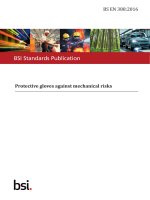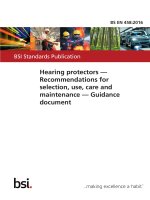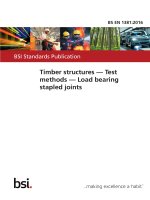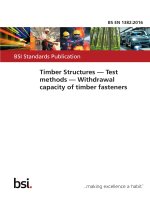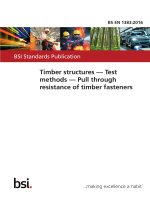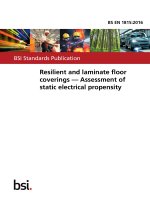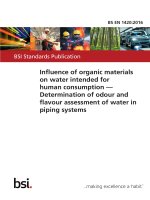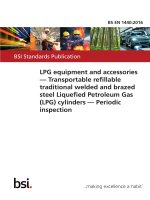Bsi bs en 62077 2016
Bạn đang xem bản rút gọn của tài liệu. Xem và tải ngay bản đầy đủ của tài liệu tại đây (1.43 MB, 30 trang )
BS EN 62077:2016
BSI Standards Publication
Fibre optic interconnecting
devices and passive components
— Fibre optic circulators —
Generic specification
BRITISH STANDARD
BS EN 62077:2016
National foreword
This British Standard is the UK implementation of EN 62077:2016. It is
identical to IEC 62077:2015. It supersedes BS EN 62077:2010 which is
withdrawn.
The UK participation in its preparation was entrusted by Technical
Committee GEL/86, Fibre optics, to Subcommittee GEL/86/2, Fibre optic
interconnecting devices and passive components.
A list of organizations represented on this committee can be obtained on
request to its secretary.
This publication does not purport to include all the necessary provisions of
a contract. Users are responsible for its correct application.
© The British Standards Institution 2016.
Published by BSI Standards Limited 2016
ISBN 978 0 580 87211 2
ICS 33.180.20
Compliance with a British Standard cannot confer immunity from
legal obligations.
This British Standard was published under the authority of the
Standards Policy and Strategy Committee on 31 March 2016.
Amendments/corrigenda issued since publication
Date
Text affected
BS EN 62077:2016
EUROPEAN STANDARD
EN 62077
NORME EUROPÉENNE
EUROPÄISCHE NORM
February 2016
ICS 33.180.20
Supersedes EN 62077:2010
English Version
Fibre optic interconnecting devices and passive components Fibre optic circulators - Generic specification
(IEC 62077:2015)
Dispositifs d'interconnexion et composants passifs à fibres
optiques - Circulateurs fibroniques - Spécification générique
(IEC 62077:2015)
Lichtwellenleiter - Verbindungselemente und passive
Bauteile - Lichtwellenleiterzirkulatoren Fachgrundspezifikation
(IEC 62077:2015)
This European Standard was approved by CENELEC on 2015-12-09. CENELEC members are bound to comply with the CEN/CENELEC
Internal Regulations which stipulate the conditions for giving this European Standard the status of a national standard without any alteration.
Up-to-date lists and bibliographical references concerning such national standards may be obtained on application to the CEN-CENELEC
Management Centre or to any CENELEC member.
This European Standard exists in three official versions (English, French, German). A version in any other language made by translation
under the responsibility of a CENELEC member into its own language and notified to the CEN-CENELEC Management Centre has the
same status as the official versions.
CENELEC members are the national electrotechnical committees of Austria, Belgium, Bulgaria, Croatia, Cyprus, the Czech Republic,
Denmark, Estonia, Finland, Former Yugoslav Republic of Macedonia, France, Germany, Greece, Hungary, Iceland, Ireland, Italy, Latvia,
Lithuania, Luxembourg, Malta, the Netherlands, Norway, Poland, Portugal, Romania, Slovakia, Slovenia, Spain, Sweden, Switzerland,
Turkey and the United Kingdom.
European Committee for Electrotechnical Standardization
Comité Européen de Normalisation Electrotechnique
Europäisches Komitee für Elektrotechnische Normung
CEN-CENELEC Management Centre: Avenue Marnix 17, B-1000 Brussels
© 2016 CENELEC All rights of exploitation in any form and by any means reserved worldwide for CENELEC Members.
Ref. No. EN 62077:2016 E
BS EN 62077:2016
EN 62077:2016
European foreword
The text of document 86B/3862/CDV, future edition 3 of IEC 62077, prepared by SC 86B "Fibre optic
interconnecting devices and passive components" of IEC/TC 86 "Fibre optics" was submitted to the
IEC-CENELEC parallel vote and approved by CENELEC as EN 62077:2016.
The following dates are fixed:
•
latest date by which the document has to be implemented at
national level by publication of an identical national
standard or by endorsement
(dop)
2016-09-09
•
latest date by which the national standards conflicting with
the document have to be withdrawn
(dow)
2016-12-09
This document supersedes EN 62077:2010.
Attention is drawn to the possibility that some of the elements of this document may be the subject of
patent rights. CENELEC [and/or CEN] shall not be held responsible for identifying any or all such
patent rights.
Endorsement notice
The text of the International Standard IEC 62077:2015 was approved by CENELEC as a European
Standard without any modification.
In the official version, for Bibliography, the following notes have to be added for the standards indicated:
2
IEC 60068
NOTE
Harmonized in EN 60068 series.
IEC 61300-2
NOTE
Harmonized in EN 61300-2 series.
IEC 61300-3
NOTE
Harmonized in EN 61300-3 series.
IEC 61753
NOTE
Harmonized in EN 61753 series.
IEC 61754
NOTE
Harmonized in EN 61754 series.
IEC 61978-1
NOTE
Harmonized as EN 61978-1.
IEC 62005
NOTE
Harmonized in EN 62005 series.
BS EN 62077:2016
EN 62077:2016
Annex ZA
(normative)
Normative references to international publications
with their corresponding European publications
The following documents, in whole or in part, are normatively referenced in this document and are
indispensable for its application. For dated references, only the edition cited applies. For undated
references, the latest edition of the referenced document (including any amendments) applies.
NOTE 1
When an International Publication has been modified by common modifications, indicated by (mod),
the relevant EN/HD applies.
NOTE 2
Up-to-date information on the latest versions of the European Standards listed in this annex is
available here: www.cenelec.eu.
Publication
Year
Title
EN/HD
Year
IEC 60027
series
Letter symbols to be used in electrical
technology
EN 60027
series
IEC 60050-731
-
International Electrotechnical
Vocabulary Chapter 731: Optical fibre
communication
-
-
IEC 60617
-
Graphical symbols for diagrams
-
-
IEC 60695-11-5
-
Fire hazard testing Part 11-5: Test flames - Needle-flame
test method - Apparatus, confirmatory
test arrangement and guidance
EN 60695-11-5
-
IEC 60825
series
Safety of laser products
EN 60825
series
IEC 61300
series
Fibre optic interconnecting devices and
passive components - Basic test and
measurement procedures
EN 61300
series
IEC/TR 61930
-
Fibre optic graphical symbology
-
-
ISO 129-1
-
Technical drawings - Indication of
dimensions and tolerances Part 1: General principles
-
-
ISO 286-1
-
Geometrical product specifications
(GPS) - ISO code system for tolerances
on linear sizes Part 1: Basis of tolerances, deviations
and fits
EN ISO 286-1
-
ISO 1101
-
Geometrical product specifications
(GPS) - Geometrical tolerancing Tolerances of form, orientation, location
and run-out
EN ISO 1101
-
ISO 8601
-
Data elements and interchange
formats - Information interchange Representation of dates and times
-
-
3
BS EN 62077:2016
–2–
IEC 62077:2015 IEC 2015
CONTENTS
FOREWORD ........................................................................................................................... 4
1
Scope .............................................................................................................................. 6
2
Normative references ...................................................................................................... 6
3
Terms and definitions ...................................................................................................... 7
3.1
Basic terms ............................................................................................................. 7
3.2
Component terms.................................................................................................... 8
3.3
Performance parameters ......................................................................................... 8
4
Requirements ................................................................................................................ 10
4.1
Classification ........................................................................................................ 10
4.1.1
General ......................................................................................................... 10
4.1.2
Type .............................................................................................................. 11
4.1.3
Style .............................................................................................................. 11
4.1.4
Variant ........................................................................................................... 12
4.1.5
Normative reference extensions..................................................................... 12
4.2
Documentation ...................................................................................................... 13
4.2.1
Symbols ........................................................................................................ 13
4.2.2
Specification system ...................................................................................... 13
4.2.3
Drawings ....................................................................................................... 15
4.2.4
Tests and measurements ............................................................................... 15
4.2.5
Test reports ................................................................................................... 16
4.2.6
Instructions for use ........................................................................................ 16
4.3
Standardization system ......................................................................................... 16
4.3.1
Interface standards ........................................................................................ 16
4.3.2
Performance standards .................................................................................. 17
4.3.3
Reliability standards ...................................................................................... 17
4.3.4
Interlinking ..................................................................................................... 18
4.4
Design and construction ........................................................................................ 19
4.4.1
Materials ....................................................................................................... 19
4.4.2
Workmanship ................................................................................................. 19
4.5
Performance ......................................................................................................... 19
4.6
Identification and marking ..................................................................................... 19
4.6.1
General ......................................................................................................... 19
4.6.2
Variant identification number ......................................................................... 19
4.6.3
Component marking ....................................................................................... 20
4.6.4
Package marking ........................................................................................... 20
4.7
Packaging ............................................................................................................. 20
4.8
Storage conditions ................................................................................................ 20
4.9
Safety ................................................................................................................... 21
Annex A (informative) Example of technology of bulk circulator based on magnetooptic effect ............................................................................................................................ 22
Annex B (informative) Example of application of a circulator ................................................ 23
Bibliography .......................................................................................................................... 24
Figure 1 – Completely circulated type configuration ................................................................ 8
Figure 2 – Incompletely circulated type configuration .............................................................. 8
BS EN 62077:2016
IEC 62077:2015 IEC 2015
–3–
Figure 3 – Insertion loss ......................................................................................................... 9
Figure 4 – Isolation ................................................................................................................. 9
Figure 5 – Optical circulator style configurations ................................................................... 12
Figure 6 – Standards currently under preparation ................................................................. 18
Figure 7 – Example of a variant identification number ........................................................... 20
Figure A.1 – Example of a circulator ..................................................................................... 22
Figure B.1 – Example of application of a circulator ................................................................ 23
Table 1 – Example of a typical circulator set classification .................................................... 11
Table 2 – The IEC specification structure .............................................................................. 14
Table 3 – Standards interlink matrix ...................................................................................... 19
BS EN 62077:2016
–4–
IEC 62077:2015 IEC 2015
INTERNATIONAL ELECTROTECHNICAL COMMISSION
____________
FIBRE OPTIC INTERCONNECTING
DEVICES AND PASSIVE COMPONENTS –
FIBRE OPTIC CIRCULATORS – GENERIC SPECIFICATION
FOREWORD
1) The International Electrotechnical Commission (IEC) is a worldwide organization for standardization comprising
all national electrotechnical committees (IEC National Committees). The object of IEC is to promote
international co-operation on all questions concerning standardization in the electrical and electronic fields. To
this end and in addition to other activities, IEC publishes International Standards, Technical Specifications,
Technical Reports, Publicly Available Specifications (PAS) and Guides (hereafter referred to as “IEC
Publication(s)”). Their preparation is entrusted to technical committees; any IEC National Committee interested
in the subject dealt with may participate in this preparatory work. International, governmental and nongovernmental organizations liaising with the IEC also participate in this preparation. IEC collaborates closely
with the International Organization for Standardization (ISO) in accordance with conditions determined by
agreement between the two organizations.
2) The formal decisions or agreements of IEC on technical matters express, as nearly as possible, an international
consensus of opinion on the relevant subjects since each technical committee has representation from all
interested IEC National Committees.
3) IEC Publications have the form of recommendations for international use and are accepted by IEC National
Committees in that sense. While all reasonable efforts are made to ensure that the technical content of IEC
Publications is accurate, IEC cannot be held responsible for the way in which they are used or for any
misinterpretation by any end user.
4) In order to promote international uniformity, IEC National Committees undertake to apply IEC Publications
transparently to the maximum extent possible in their national and regional publications. Any divergence
between any IEC Publication and the corresponding national or regional publication shall be clearly indicated in
the latter.
5) IEC itself does not provide any attestation of conformity. Independent certification bodies provide conformity
assessment services and, in some areas, access to IEC marks of conformity. IEC is not responsible for any
services carried out by independent certification bodies.
6) All users should ensure that they have the latest edition of this publication.
7) No liability shall attach to IEC or its directors, employees, servants or agents including individual experts and
members of its technical committees and IEC National Committees for any personal injury, property damage or
other damage of any nature whatsoever, whether direct or indirect, or for costs (including legal fees) and
expenses arising out of the publication, use of, or reliance upon, this IEC Publication or any other IEC
Publications.
8) Attention is drawn to the Normative references cited in this publication. Use of the referenced publications is
indispensable for the correct application of this publication.
9) Attention is drawn to the possibility that some of the elements of this IEC Publication may be the subject of
patent rights. IEC shall not be held responsible for identifying any or all such patent rights.
International Standard IEC 62077 has been prepared by subcommittee 86B: Fibre optic
interconnecting devices and passive components, of IEC technical committee 86: Fibre optics.
This third edition cancels and replaces the second edition published in 2010. This edition
constitutes a technical revision.
This edition includes the following significant technical changes with respect to the previous
edition:
a) harmonization of some terms and definitions with other generic specifications,
b) deletion of assessment level.
BS EN 62077:2016
IEC 62077:2015 IEC 2015
–5–
The text of this standard is based on the following documents:
CDV
Report on voting
86B/3862/CDV
86B/3918/RVC
Full information on the voting for the approval of this standard can be found in the report on
voting indicated in the above table.
This publication has been drafted in accordance with the ISO/IEC Directives, Part 2.
The committee has decided that the contents of this publication will remain unchanged until
the stability date indicated on the IEC website under "" in the data
related to the specific publication. At this date, the publication will be
•
reconfirmed,
•
withdrawn,
•
replaced by a revised edition, or
•
amended.
A bilingual version of this publication may be issued at a later date.
BS EN 62077:2016
–6–
IEC 62077:2015 IEC 2015
FIBRE OPTIC INTERCONNECTING
DEVICES AND PASSIVE COMPONENTS –
FIBRE OPTIC CIRCULATORS – GENERIC SPECIFICATION
1
Scope
This International Standard applies to circulators used in the field of fibre optics bearing all of
the following features:
–
they are non-reciprocal optical devices, in which each port is either an optical fibre or fibre
optic connector;
–
they are passive devices in accordance with the categorization and definition provided in
IEC TS 62538;
–
they have three or more ports for directionally transmitting optical power.
An example of optical circulator technology is described in Annex A.
2
Normative references
The following documents, in whole or in part, are normatively referenced in this document and
are indispensable for its application. For dated references, only the edition cited applies. For
undated references, the latest edition of the referenced document (including any
amendments) applies.
IEC 60027 (all parts), Letter symbols to be used in electrical technology
IEC 60050-731, International Electrotechnical Vocabulary – Chapter 731: Optical fibre
communication (available at )
IEC 60617, Graphical symbols for diagrams (available at />IEC 60695-11-5, Fire hazard testing – Part 11-5: Test flames – Needle-flame test method –
Apparatus, confirmatory test arrangement and guidance
IEC 60825 (all parts), Safety of laser products
IEC 61300 (all parts), Fibre optic interconnecting devices and passive components
IEC TR 61930, Fibre optic graphical symbology
ISO 129-1, Technical drawings – Indication of dimensions and tolerances – Part 1: General
principles
ISO 286-1, Geometrical product specifications (GPS) – ISO code system for tolerances on
linear sizes – Part 1: Basis of tolerances, deviations and fits
ISO 1101, Geometrical product specifications (GPS) – Geometrical tolerancing – Tolerances
of form, orientation, location and run-out
ISO 8601, Data elements and
Representation of dates and times
interchange
formats
–
Information
interchange
–
BS EN 62077:2016
IEC 62077:2015 IEC 2015
3
–7–
Terms and definitions
For the purposes of this document, the terms and definitions given in IEC 60050-731and the
following apply.
3.1
Basic terms
3.1.1
port
optical fibre or optical fibre connector attached to a passive component for the entry and/or
exit of the optical power
3.1.2
transfer matrix
n × n matrix of coefficients where n is the number of ports, and the coefficients represent the
fractional optical power transferred between designated ports
Note 1 to entry:
In general, the transfer matrix T is:
T =
t11
t n1
.... t1n
t12
t 22
t ij
t n2
t nn
(1)
where
t ij
is the ratio of the optical power P ij transferred out of port j with respect to input power P i into port i, that is:
tij =
Pij
(2)
Pi
3.1.3
transfer coefficient
element t ij of the transfer matrix
3.1.4
logarithmic transfer matrix
n × n matrix of logarithmic transfer coefficients of a ij where n is the number of ports
Note 1 to entry:
In general, the logarithmic transfer matrix A is:
a11
A=
a n1
a12
a22
...
aij
an2
a1n
a nn
(3)
where a ij is the optical power reduction, in decibels, out of port j with unit power into port i, that is:
aij = −10 log10 tij
where t ij is the transfer matrix coefficient.
3.1.5
conducting port pair
two ports i and j between which t ij is nominally greater than zero
(4)
BS EN 62077:2016
–8–
IEC 62077:2015 IEC 2015
3.1.6
isolated port pair
two ports i and j between which t ij is nominally zero, and a ij is nominally infinite
3.2
Component terms
3.2.1
fibre optic circulator
passive component possessing three or more ports which input and output are cyclic
Note 1 to entry: In the case of 3 ports circulator with port 1, port 2 and port 3, supposing optical power is
transmitted from port 1 to port 2, optical power from port 2 is transmitted to port 3.
3.2.2
completely circulated type
type of circulator where all ports can function as both input and output.
Note 1 to entry: In the case of a 3 port circulator with port 1, port 2 and port 3, where optical power is transmitted
from port 1 to port 2, optical power from port 2 is also transmitted to port 3 and optical power from port 3 is also
transmitted to port 1 (see Figure 1).
Circulator
port 1
port 3
port 2
IEC
Figure 1 – Completely circulated type configuration
3.2.3
incompletely circulated type
type of circulator where a port is either an input or an output
Note 1 to entry: In the case of 3 ports circulator with port 1, port 2 and port 3, supposing optical power is
transmitted from port 1 to port 2, optical power from port 2 is transmitted to port 3 and optical power from port 3 is
not transmitted to port 1 (see Figure 2).
Circulator
port 1
port 3
port 2
IEC
Figure 2 – Incompletely circulated type configuration
3.3
Performance parameters
3.3.1
insertion loss
element a ij of the logarithmic transfer matrix of an input port i and output port j to which optical
power is transmitted
Note 1 to entry: The insertion loss is the reduction in optical power between an input and output port of a passive
component (see Figure 3), expressed in decibels and defined as follows:
Pj
aij = −10 log10
Pin
(5)
BS EN 62077:2016
IEC 62077:2015 IEC 2015
–9–
where
P in
is the optical power launched into the input port;
Pj
is the optical power received from the output port
Supposing optical power is
transmitted from port i to port j
Circulator
input port i
output port j
IEC
Figure 3 – Insertion loss
3.3.2
isolation
element a ji of the logarithmic transfer matrix of an output port j and input port i to which optical
power is transmitted in the direction opposite to the insertion loss
Note 1 to entry: The isolation is the reduction in optical power between an input and output port of a passive
component, expressed in decibels and defined as follows:
a ji = −10 log10
Pi
Pj
(6)
where
Pi
is the optical power received from the input port;
Pj
is the optical power launched into the output port
Circulator
Supposing optical power is
transmitted from port i to port j
input port i
output port j
IEC
Figure 4 – Isolation
3.3.3
directivity
element a ik of the logarithmic transfer matrix port i and port k, which are not port pair for
insertion loss (IL), return loss (RL) or isolation (Iso)
Note 1 to entry: For example, the transmission matrix for a 4-port incompletely circulated type optical circulator,
the symbol Dir indicates directivity as in Equation (7).
a11
a21
a31
a41
a12
a22
a32
a42
a13
a 23
a33
a43
a14 RL
a24 Iso
=
a34 Dir
a44 Dir
IL
RL
Iso
Dir
Dir
IL
RL
Iso
Dir
Dir
IL
RL
(7)
BS EN 62077:2016
– 10 –
IEC 62077:2015 IEC 2015
where
Dir
is the directivity;
IL
is the insertion loss;
Iso
is the isolation;
RL
is the return loss.
3.3.4
operating wavelength
nominal wavelength, λ , at which a passive component is designed to operate with the
specified performance
3.3.5
operating wavelength range
specified range of wavelengths from λ i min to λ i max close to a nominal operating wavelength
λ i , within which a passive component is designed to operate with the specified performance
3.3.6
return loss
element a ii in Equation (8) of the logarithmic transfer matrix
Note 1 to entry:
and defined as:
It is the fraction of the input power that is returned from the input port of a passive component
P
aii = −10 log10 refl
Pi
where
Pi
is the optical power launched into the i port;
P refl
is the optical power received back from i port
4
Requirements
4.1
Classification
4.1.1
General
Fibre optic circulators shall be classified as follows:
–
type;
–
style;
–
variant;
–
normative reference extensions.
An example of a typical circulator classification is given in Table 1:
(8)
BS EN 62077:2016
IEC 62077:2015 IEC 2015
– 11 –
Table 1 – Example of a typical circulator set classification
Type:
Style:
Variants:
4.1.2
–
Three port circulator
–
Completely circulated type
–
Operating wavelength range: O-band
–
Configuration: B
–
Connector type: SC
–
Fibre type: IEC Category B 1.2
–
Means of mounting
Type
Circulators are mainly divided into types according to their configuration.
•
Port numbers;
•
Circulated type:
•
•
–
completely circulated type;
–
incompletely circulated type;
Operational principles:
–
magneto-optic Faraday effect;
–
magneto-optic Cotton-Mouton effect and Kerr effect;
Operating wavelength range:
–
O-band;
–
C-band;
–
L-band;
–
other wavelength circulators.
4.1.3
Style
Optical circulators may be classified into styles based upon fibre type(s), connector type(s),
cable type(s), housing shape and dimensions, and configuration.
The configuration of the circulator ports is classified as follows (See Figure 5):
BS EN 62077:2016
– 12 –
IEC 62077:2015 IEC 2015
Circulator
Pigtail
Pigtail
Pigtail
a)
IEC
Configuration A – Device containing integral fibre optic pigtails without a connector
Circulator
Connector
Connector
Connector
b)
IEC
Configuration B – Device containing integral fibre optic pigtails, with a connector on each pigtail
Circulator
Connector
Connector
Connector
c)
IEC
Configuration C – Device containing connectors as an integral part of the device housing
Circulator
Connector
Pigtail
Connector
IEC
d) Configuration D Example – Device containing some combination
of the interfacing features of the preceding configurations
Figure 5 – Optical circulator style configurations
4.1.4
Variant
The circulator variant identifies those common features which encompass structurally similar
components. Examples of features which define a variant include, but are not limited to, the
following:
–
position and orientation of ports on housing;
–
means of mounting.
4.1.5
Normative reference extensions
Normative reference extensions are used to identify integrated independent standards
specifications or other reference documents as relevant specifications.
Unless otherwise specified, additional requirements of extensions are mandatory. Usage is
primarily intended to merge associated components to form hybrid devices, or integrated
functional application requirements that are dependent on technical expertise other than fibre
optics.
Some optical fibre circulator configurations require special qualification provisions which shall
not be imposed universally. This accommodates individual component design configurations,
specialized field tooling or specific application processes. In this case, the requirements are
necessary to assure repeatable performance or adequate safety, and provide additional
BS EN 62077:2016
IEC 62077:2015 IEC 2015
– 13 –
guidance for complete product specification. These extensions are mandatory whenever used
to prepare, assemble or install an optical fibre circulator, either for field application usage or
preparation of qualification test specimens. The relevant specification shall clarify all
stipulations. However, design and style dependent extensions shall not be imposed
universally.
In the event of conflicting requirements, precedence shall be given, in descending order, as
follows: generic over mandatory extension, over relevant, over detail, over application specific
extension.
Examples of requirements to normative extensions:
–
some commercial or residential building applications may require direct reference to
specific safety codes and regulations or incorporate other specific material flammability or
toxicity requirements for specialized locations;
–
specialized field tooling may require an extension to implement specific ocular safety,
electrical shock, burn hazard avoidance requirements, or require isolation procedures to
prevent potential ignition of combustible gases.
4.2
Documentation
4.2.1
Symbols
Graphical and letter symbols shall, whenever possible, be taken from the IEC 60027 series,
IEC 60617 and IEC TR 61930.
4.2.2
4.2.2.1
Specification system
General
This generic specification is part of a three-level IEC specification system. Subsidiary
specifications shall consist of relevant specifications. This system is shown in Table 2. There
are no sectional specifications for circulators.
BS EN 62077:2016
– 14 –
IEC 62077:2015 IEC 2015
Table 2 – The IEC specification structure
Specification level
Basic
Generic
Blank detail
Detail
4.2.2.2
Examples of information to be included
–
Assessment system rules
–
Inspection rules
–
Optical measurement methods
–
Environmental test methods
–
Sampling plans
–
Identification rule
–
Marking standards
–
Dimensional standards
–
Terminology
–
Symbol standards
–
Preferred number series
–
SI units
–
Specific terminology
–
Specific symbols
–
Specific units
–
Preferred values
–
Marking
–
Selection of tests
–
Capability approval procedures
–
Quality conformation test schedule
–
Inspection requirements
–
Information common to a number of types
–
Individual values
–
Specific information
–
Completed quality conformance test
schedules
Applicable to
Two or more component families or
sub-families
Component family
Groups of types and/or styles having a
common test schedule
Individual component(s)
Blank detail specifications
The blank detail specification lists all of the parameters and features applicable to a fibre
optic circulator, including the type, operating characteristics, housing configurations, test
methods, and performance requirements. The blank detail specification is applicable to any
fibre optic circulator design and quality assessment requirement. The blank detail
specification contains the preferred format for stating the required information in the detail
specification.
Blank detail specifications are not, by themselves, a specification level. They are associated
with the generic specification.
Each blank detail specification shall be limited to one environmental category.
Each blank detail specification shall contain:
–
the minimum mandatory test schedules and performance requirements,
–
the preferred format for stating the required information in the detail specification,
–
in case of hybrid components, including connectors, addition of appropriate entry fields to
show the reference normative document, document title and issue date.
4.2.2.3
Detail specifications
A specific circulator is described by a corresponding detail specification, which is prepared by
filling in the blanks of the blank detail specification. Within the constraints imposed by this
BS EN 62077:2016
IEC 62077:2015 IEC 2015
– 15 –
generic specification, the blank detail specification may be filled in by any national committee
of the IEC, thereby defining a particular circulator as an IEC standard.
Detail specifications shall specify the following, as applicable:
–
type (see 4.1.2);
–
style (see 4.1.3);
–
variant(s) (see 4.1.4);
–
part identification number for each variant (see 4.6.2);
–
drawings, dimensions required (see 4.2.3);
–
test schedules (see 4.2.5);
–
performance requirements (see 4.5).
4.2.3
4.2.3.1
Drawings
General
The drawings and dimensions given in relevant specifications shall not restrict themselves to
details of construction, nor shall they be used as manufacturing drawings.
4.2.3.2
Projection system
Either first-angle or third-angle projection shall be used for the drawings in documents
covered by this generic specification. All drawings within a document shall use the same
projection system and the drawings shall state which system is used.
4.2.3.3
Dimensional system
All dimensions shall be given in accordance with ISO 129-1, ISO 286-1 and ISO 1101.
The metric system shall be used in all specifications.
Dimensions shall not contain more than five significant digits.
Conversion between systems of units shall be done correctly. When units are converted, a
note shall be added in each relevant specification. Conversion between metric and imperial
units shall use a factor of 25,4 mm to 1 inch.
4.2.4
4.2.4.1
Tests and measurements
Test and measurement procedures
The test and measurement procedures for optical, mechanical, climatic, and environmental
characteristics of circulators to be used shall be defined and selected preferably from the
IEC 61300 series.
The size measurement method to be used shall be specified in the relevant specification for
dimensions which are specified within a total tolerance zone of 0,01 mm or less.
4.2.4.2
Reference components
Reference components, if required, shall be specified in the relevant specification.
4.2.4.3
Gauges
Gauges, if required, shall be specified in the relevant specification.
BS EN 62077:2016
– 16 –
4.2.5
IEC 62077:2015 IEC 2015
Test reports
Test reports shall be prepared for each test conducted as required by a relevant specification.
The reports shall be included in the qualification report and in the periodic inspection report.
Reports shall contain the following information:
–
title of test and date;
–
specimen description including the type of fibre, connector or other coupling device. The
description shall also include the variant identification number (see 4.6.2);
–
test equipment used and date of latest calibration;
–
all applicable test details;
–
all measurement values and observations;
–
sufficiently detailed documentation to provide traceable information for failure analysis.
4.2.6
Instructions for use
Instructions for use, when required, shall be given by the manufacturer and shall include:
–
assembly and connection instructions;
–
cleaning method;
–
safety aspects;
–
additional information, as necessary.
4.3
4.3.1
Standardization system
Interface standards
Interface standards provide both manufacturer and user with all the information required to
make or use the product in conformity with the physical features of that standard interface.
Interface standards fully define the features essential for the mating and unmating of optical
fibre connectors and other components. They also serve to position the optical datum target,
where defined, relative to other reference datum.
Interface standards ensure that connectors and adapters that comply with the standard will fit
together. The standards may also contain tolerance grades for ferrules and alignment devices.
Tolerance grades are used to provide different levels of alignment precision.
The interface dimensions may also be used to design other components that will mate with
the connectors. For example, an active device mount can be designed using the adapter
interface dimensions. The use of these dimensions combined with those of a standard plug
provides the designer with assurance that the standard plugs will fit into the optical device
mount. They also provide the location of the plug's optical datum target.
Standard interface dimensions do not, by themselves, guarantee optical performance. They
guarantee connector mating at a specified fit. Optical performance is currently guaranteed via
the manufacturing specification. Products from the same or different manufacturing
specifications using the same standard interface will always fit together. Guaranteed
performance can be given by any single manufacturer only for product delivered to the same
manufacturing specification. However, it can be reasonably expected that some level of
performance will be obtained by mating a product from different manufacturing specifications,
although the level of performance cannot be expected to be any better than that of the lowest
specified performance.
BS EN 62077:2016
IEC 62077:2015 IEC 2015
4.3.2
– 17 –
Performance standards
Performance standards contain a series of tests and measurements (which may or may not be
grouped into a specified schedule depending on the requirements of that standard) with
clearly defined conditions, severities, and pass/fail criteria. The tests are intended to be run
on a “one-off” basis to prove the ability of a given product to satisfy the “performance
standards” requirement. Each performance standard has a different set of tests and/or
severities (and/or groupings) that represents the requirements of a market sector, user group
or system location.
A product that has been shown to meet all the requirements of a performance standard can
be declared as complying with a performance standard but should then be controlled by a
quality assurance/quality conformance programme.
It is possible to define a key point of the test and measurements standards when these are
applied (particularly with regard to insertion loss and return loss) in conjunction with the
interface standards of inter-product compatibility. This ensures conformance of each
individual product to this standard.
4.3.3
Reliability standards
Reliability standards are intended to ensure that a component can meet performance
specifications under stated conditions for a stated time period.
For each type of component, the following shall be identified (and appear in the standard):
•
failure modes (observable general mechanical or optical effects of failure);
•
failure mechanisms (general causes of failure, which may be common to several
components);
•
failure effects (detailed causes of failure, specific to component).
These are all related to environmental and material aspects.
Initially, just after component manufacture, there is an “infant mortality phase” during which
many components would fail if they were deployed in the field. To avoid early field failure, all
components may be subjected to screen process in the factory, involving environmental
stresses that may be mechanical, thermal and humidity-related. This is to induce known
failure mechanisms in a controlled environmental situation to occur earlier than would
normally be seen in the unscreened population. For those components that survive (and are
then sold), there is a reduced failure rate since these mechanisms have been eliminated.
Screening is an optional part of the manufacturing process, rather than a test method. It will
not affect the “useful life” of a component, defined as the period during which it performs
according to specifications. Eventually other failure mechanisms appear, and the failure rate
increases beyond some defined threshold. At this point, the useful life ends and the “wear-out
region” begins, and the component must be replaced.
At the beginning of useful life, performance testing on a sampled population of components
may be applied by the supplier, by the manufacturer, or by a third party. This is to ensure that
the component meets performance specifications over the range of intended environments at
this initial time. Reliability testing, on the other hand, is applied to ensure that the component
meets performance specifications for at least a specified minimum useful lifetime or specified
maximum failure rate. These tests are usually carried out by utilising the performance testing,
but increasing duration and severity to accelerate the failure mechanisms.
A reliability theory relates component reliability testing to component parameters and to
lifetime or failure rate under testing. The theory then extrapolates these to lifetime or failure
rate under less stressful service conditions. The reliability specifications include values of the
BS EN 62077:2016
– 18 –
IEC 62077:2015 IEC 2015
component parameters needed to ensure the specified minimum lifetime or maximum failure
rate in service.
4.3.4
Interlinking
Standards currently under preparation are given in Figure 6. A large number of the test and
measurement standards exist already and quality assurance qualification approval standards
have existed for many years. With regard to interface, performance and reliability standards,
once these three standards are all in place, the matrix given in Table 6 demonstrates some of
the other options available for product standardization.
Product A is fully IEC standardized, having a standard interface and meeting defined
performance standards and reliability standards.
Product B is a product with a proprietary interface but which meets a defined IEC performance
standard and reliability standard.
Product C is a product which complies with an IEC standard interface but does not meet the
requirements of either an IEC performance standard or reliability standard.
Product D is a product which complies with both an IEC standard interface and performance
standard but does not meet any reliability requirements.
Obviously the matrix is more complex than shown since there will be a number of interface,
performance and reliability standards which may cross-refer. In addition, the products may all
be subject to a recognized quality assurance programme including qualification approval,
capability approval, technology approval or even a national or company quality assurance
system.
Test and
measurement
See
IEC 61300
series
IEC 60068
series
Interface
Performance
Reliability
See
IEC 61754
series
See
IEC 61753
series
See
IEC 62005
series
IEC specification
structure:
------------------Generic
specification
Sectional
specification
Detail
specification
IEC
Figure 6 – Standards currently under preparation
BS EN 62077:2016
IEC 62077:2015 IEC 2015
– 19 –
Table 3 – Standards interlink matrix
4.4
Product type
Interface
standard
Performance
standard
Reliability
standard
Product A
YES
YES
YES
Product B
NO
YES
YES
Product C
YES
NO
NO
Product D
YES
YES
NO
Design and construction
4.4.1
Materials
4.4.1.1
Corrosion resistance
All materials used in the construction of circulator sets shall be corrosion resistant or suitably
finished to meet the requirements of the relevant specification.
4.4.1.2
Non-flammable materials
When non-flammable materials are required, the requirements shall be specified in the
relevant specification and IEC 60695-11-5 shall be referenced.
4.4.2
Workmanship
Components and associated hardware shall be manufactured to a uniform quality and shall be
free of sharp edges, burrs or other defects that will affect life, serviceability, or appearance.
Particular attention shall be given to neatness and thoroughness of marking, plating, soldering,
bonding, etc.
4.5
Performance
Circulators shall meet the performance requirements specified in the relevant specification.
4.6
4.6.1
Identification and marking
General
Components, associated hardware and packages shall be permanently and legibly identified
and marked when required by the relevant specification.
4.6.2
Variant identification number
Each variant in a relevant specification shall be assigned a variant identification number. The
number shall consist of the number assigned to the relevant specification followed by a dash
and a four digit number. The first digit of the four-digit number shall be sequentially assigned
to each component type covered by the relevant specification. The last three digits shall be
sequentially assigned to each variant of the component (see Figure 7).
BS EN 62077:2016
– 20 –
EXAMPLE
IEC 62077:2015 IEC 2015
IEC 61753-091-2-1 001
Relevant specification number
Component type
Variant
IEC
Figure 7 – Example of a variant identification number
4.6.3
Component marking
Component marking, if required, shall be specified in the relevant specification. The preferred
order of marking is as follows:
a) port identification;
b) manufacturer's part number;
c) manufacturer's identification mark or logo;
d) manufacturing date;
e) variant identification number;
f)
any additional marking required by the relevant specification.
If space does not allow for all the required marking on the components, each unit shall be
individually packaged with a data sheet containing all of the required information which is not
marked.
4.6.4
Package marking
Package marking, if required, shall be specified in the relevant specification. The preferred
order of marking is as follows:
a) manufacturer's identification mark or logo;
b) manufacturer's part number;
c) manufacturing date code (year/week; see ISO 8601);
d) variant identification number(s) (see 4.6.2);
e) type designations (see 4.1.2);
f)
any additional marking required by the relevant specification.
When applicable, individual unit packages (within the sealed package) shall be marked with
the reference number of the certified record of released lots, the manufacturer's factory
identity code and the component identification.
4.7
Packaging
Packages shall include instructions for use when required by the specification (see 4.2.6).
4.8
Storage conditions
Where short-term degradable materials, such as adhesives, are supplied with the package of
circulator parts, the manufacturer shall mark these with the expiry date (year and week
numbers, see ISO 8601) together with any requirements or precautions concerning safety
hazards or environmental conditions for storage.
BS EN 62077:2016
IEC 62077:2015 IEC 2015
4.9
– 21 –
Safety
Optical circulators, when used on an optical fibre transmission system and/or equipment, may
emit potentially hazardous radiation from an uncapped or unterminated output port or fibre
end.
The optical circulator manufacturers shall make available sufficient information to alert system
designers and users about the potential hazard and shall indicate the required precautions
and working practices.
In addition, each relevant specification shall include the following:
WARNING NOTE
Care should be taken when handling small diameter fibre to prevent puncturing the skin, especially in the
eye area. Direct viewing of the end of an optical fibre or an optical fibre connector when it is propagating
energy is not recommended, unless prior assurance has been obtained as to the safety energy output level.
Reference shall be made to the IEC 60825 series, the relevant standard on safety.

